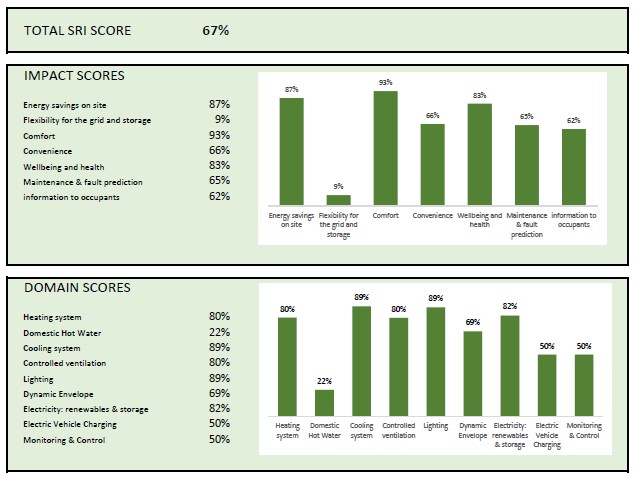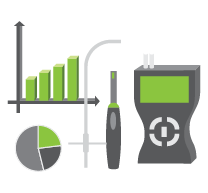
SRI smart readiness indicator
Smart building is such a building, which adapt the operation to the needs of the occupants (e.g. control of HVAC and lighting systems), and to the grid (e.g. demand response, smart meter), and use information and communication technologies and electronic systems (e.g. building management system accessible via the internet).
The EPBD required the development of a voluntary European scheme for rating the smart readiness of buildings.
The SRI aims to make the added value of building smartness more tangible for building users, owners and tenants. The voluntary scheme has been developed and tested by a consortium (VITO, Waide Strategic Efficiency Europe), ordered by the European Commission. The proposed SRI methodology is a qualitative labelling scheme. The SRI assessment procedure is based on the smart ready services, which are present in a building and an evaluation of the functionalities they can offer. Each of the services can be implemented with various degrees of “smartness” (referred to as “functionality levels”). The smart ready services are structured within 9 domains:
1. Heating
2. Cooling
3. Domestic hot water
4. Controlled ventilation
5. Lighting
6. Dynamic building envelope
7. Electricity
8. Electric vehicle charging
9. Monitoring and control
For each of the smart ready services, 2 to 5 functionality levels are defined. A higher functionality level reflects a “smarter” implementation of the service, which generally provides more beneficial impacts to building users or to the grid compared to services implemented at a lower functionality level.
A smart ready service can provide several impacts to the users and to the energy grid. Seven impact categories have been considered:
1. Energy savings on site
This impact category refers to the impacts of the smart ready services on energy saving capabilities. It is not the whole energy performance of buildings that is considered, but only the contribution made to this by smart ready technologies, e.g. resulting from better control of room temperature settings.
2. Flexibility for the grid and storage
This impact category refers to the impacts of services on the energy flexibility potential of the building.The study proposes to not solely focus on electricity grids, but also include flexibility offered to district heating and cooling grids.
3. Comfort
This impact category refers to the impacts of services on occupant’s comfort. Comfort refers to conscious and unconscious perception of the physical environment, including thermal comfort, acoustic comfort and visual performance (e.g. provision of sufficient lighting levels without glare).
4. Convenience
This impact category refers to the impacts of services on convenience for occupants, i.e. the extent to which services “make life easier” for the occupant, e.g. TBS requiring less manual interactions.
5. Well-being and health
This impact category refers to the impacts of services on the well-being and health of occupants. For instance, smarter controls can deliver an improved indoor air quality compared to traditional controls, thus raising occupants’ well-being, with a commensurate impact on their health.
6. Maintenance and fault prediction
Automated fault detection and diagnosis has the potential to significantly improve maintenance and operation of technical building systems. It also has potential impacts on the energy performance of the technical building systems by detecting and diagnosing inefficient operation.
7. Information to occupants
This impact category refers to the impacts of services on the provision of information on building operation to occupants.
The SRI score calculating starts with the assessment of individual smart ready services: services available in the building are inspected and their functionality level is determined. After these individual services impact scores are known, an aggregated impact score is calculated for each of the 9 smart-ready domains. This domain impact score is calculated as the ratio (expressed as a percentage) between individual scores of the domains’ services and theoretical maximum individual scores. For the 7 impact categories, a total impact score is then calculated as a weighted sum of the domain impact scores. The SRI score is then derived as a weighted sum of the 7 total impact scores.

The SRI scheme can be used to map areas where it is worthwhile to intervene in order to make the building more intelligent, better suited to the needs of users and the grid. We recommend the SRI certification to be prepared primarily for larger buildings. THe SRI method is suitable for the inspection of existing buildings or for inspection of new buildings, even in the design phase.
If you need SRI calculation, please contact us!



CONTACT
2310 Szigetszentmiklós, Deák Ferenc str. 2. fszt. 3.
TELEPHONE+36 30 964 2500












